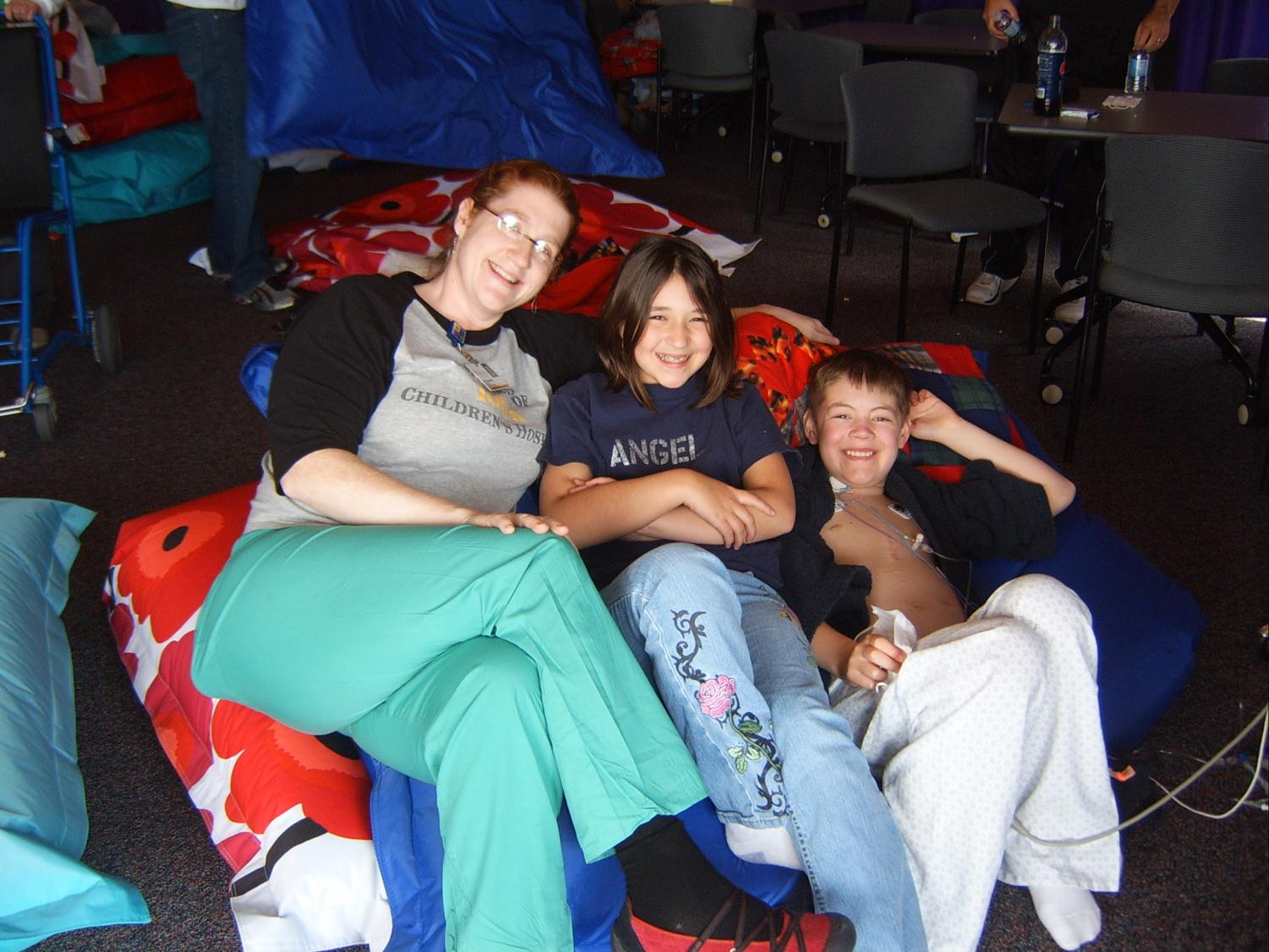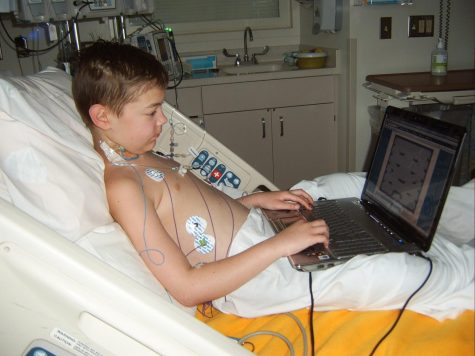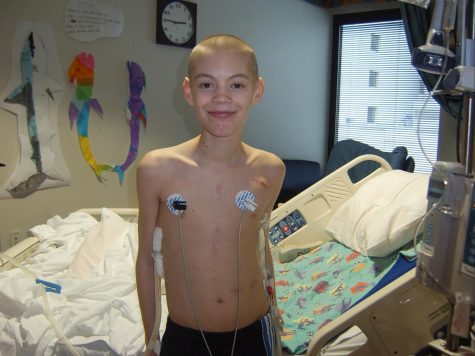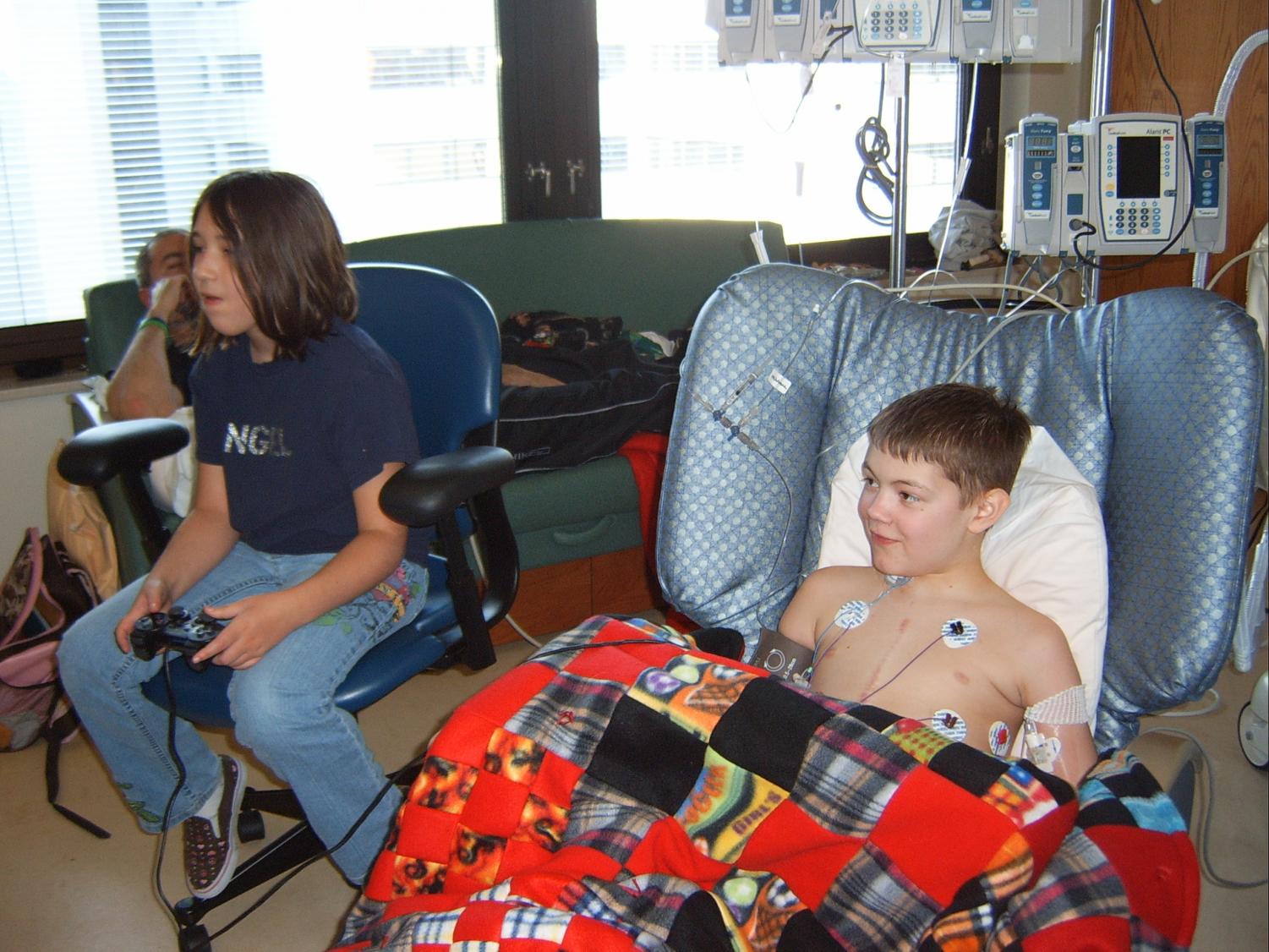My brother died when I was 11. The UI Children’s Hospital’s sibling program helped me through.
A DI staffer’s life changed in a fundamental way when she became the sibling of a terminally ill child. This is the story of how the University of Iowa Children’s Hospital’s Child Life program helped her family get through hard times.
March 7, 2019
Even before my brother’s heart started to fail, I defined myself by him. I was more obedient than him, did better in school than him, and could do more on my own than him. I wasn’t as good at video games, making people laugh, or being genuine.
After he got sick, everyone else began to do the same thing.
Being the sibling of a child with an acute illness turns you into a new person. I probably had an advantage since I had always taken care of Bryce, even if I was two years younger, but I still had to relearn how to act around him and others. I had to learn how to be gentle, how to step aside, how to deal with the fact that everyone would always ask how he was doing before they asked about me — not an easy feat for a 9-year-old, but the staff at Child Life at at the University of Iowa Children’s Hospital helped me get through, along with siblings all over the U.S.

The Draisey family stands for a portrait on Tuesday, March 5, 2019.
On the morning of Feb. 19, 2008, my brother and I went to Willowbrook Elementary School unaware of what the day would bring. While I was in class, Bryce went to the nurse’s office because he couldn’t stay awake. He had been dealing with a virus for a while, and it had made him tired. This time, though, after he went to sleep, his fingers and lips turned blue. Our parents brought him to the emergency room in Des Moines, where they transferred him to the UI Children’s Hospital, an hour and a half away from our home in Altoona.
I wasn’t able to see Bryce for a few days after he went to the hospital, so I stayed with my grandmother. All I knew at the time was my brother was very sick, he wouldn’t be leaving the hospital anytime soon, and my parents had to be with him. We spoke on the phone when we could, but obviously, it was a crazy time, so I didn’t know everything that was going on.
My clearest memory from those few days was trying to hold it together with my grandmother, before finally asking her, “Is everything going to be OK?” and crying. Everything was uncertain, and I didn’t really know how to handle it.
Before I got to see my brother, I was given a packet full of information about the Children’s Hospital and what Bryce was going through. It had pictures of the hospital rooms and descriptions of what Bryce might look like. Child Life makes packets like these to prepare siblings for what they were going to see and what was going to happen.
While the whole experience was kind of scary, getting to see the floor and his room number beforehand was a huge relief. I basically had no idea what I was walking into and having information such as when I need to wash my hands and why Bryce would be hooked up to so many machines went a long way in helping me not to freak out. I loved learning, so the packet gave me something to focus on other than the fact that Bryce was really sick.
Child Life is a program embedded in many children’s hospitals to help kids and their families cope with illness and being in the hospital. They create distraction through different activities and work with all members of the family to make sure the transition is as smooth as possible.
Bryce didn’t leave the hospital for five and a half months, until he got his heart on July 16, 2008. What followed was a year and a half of the best of times, and the worst of times. He got to come home a few weeks after the transplant and lived like a normal kid. We even got to go on a Disney Cruise for free through the Make-A-Wish Foundation.
Four months later, Bryce’s body began to reject his new heart, and in March 2009, he went back on the transplant list. He had to go back to the hospital for a while, but eventually he got well enough to come home. He had a nurse with him and was home schooled more often than not, but he was home.

I remember feeling happiness in the back of my mind all the time, no matter what was happening. We bickered and fought about stupid things, and I was jealous that he didn’t have to get up early and go to school, but he was around, and that’s all I cared about.
In April 2010, his heart got worse again, so he had to go back in the hospital. After Bryce’s last surgery to get put back on the LVAD, he suffered a stroke too damaging to recover from. Bryce died on May 3, 2010, when he was 13, and I was 11.
During this time, life shifted into a new normal for me. During his longest stay in the hospital, I stayed there on weekends and visited on Wednesday nights. My mom stayed at the hospital and worked from her computer during the first half of the week, then came come home to Altoona with my dad and me after our Wednesday visit. A lot of the time grandparents were around to stay with Bryce when we couldn’t.
Many people picture hospitals as how they look on TV — cold, with white walls and a bleak atmosphere. That is the exact opposite of how I saw, and still see it. The Pediatric Intensive Care Unit on the seventh floor was my playground, and everyone there was my friend. I can still remember the carpet underneath my bare feet as I ran down the hallways, my brother ticking along behind me. The machine that kept him alive, his LVAD, made a clicking noise, so we called it his “ticker.”
For a glimpse into the life of Bryce Draisey, watch this video:
My dad, Derek Draisey, said I was a rock and that when I was around, Bryce’s hospital room turned into a home. We bickered like nothing had changed, because between us, nothing had. He was still my annoying older brother who wouldn’t let me have a turn on the PlayStation 2, and I was still the dumb younger sister who was always whining about something.
“When you would come, Bryce would be better,” he tells me today.
We would take toys from the cabinets behind the nurses’ station, “borrow” craft supplies that we never gave back, and even steal gloves and saline syringes if we were in a mischievous mood, which Bryce was almost always in. Gloves were turned into balloons, and saline solution was sprayed on unsuspecting doctors and nurses.
One of my dad’s favorite memories from the hospital is the music videos Bryce and I made with action figures. It was just us joking around with nothing weighing on our minds, and we didn’t even know he was recording.
To keep us from descending into too much chaos, Child Life was there.
“We help to keep the environment as normal as we can for patients and their families,” UI Child Life specialist Racheal Niensteadt said. She and Robin Ostedgaard, another Child Life specialist, worked with Bryce and me while he was in the hospital and after.

For us, that meant crafts, games, and the occasional prank. Bryce also used music as a way of expressing himself and worked with the music therapist to learn guitar and record songs.
A large portion of Child Life is dedicated to the patients themselves, but there is also programming dedicated specifically to siblings.
Child Life gave me the space to be a kid, not having to worry about anything for a while. Going to late-night bingo and afternoon play dates got me out of the room and out of my own head.
“Always in the back of our minds we’re thinking, ‘We can’t forget about that brother or sister at home,’ ” Niensteadt said.
My favorite thing about Child Life was Sibling Support Group. Once a month on Saturday morning, I would head down to a tucked-away corner of the first floor of the hospital, which housed a game room and a gym. For a few hours, siblings of sick kids played sports, instruments, and video games and learned about procedures that patients might have to go through. One day we learned about biopsies, another day we got to put IVs in dolls. Getting to operate on toys was always my favorite.
The Child Life specialists and volunteers also led us through exercises on identifying and dealing with emotions. I remember one day where each of us got a sketchbook, and we drew our emotions while listening to specific songs. I mostly used colors to express what I was feeling, then just drew random doodles in those colors. Mint green for calm, blue for sad, orange for happy. Then we would talk about what we were feeling, which helped us work through them.
“It let you hang out with kids who were there for the same reason as you. Although their siblings weren’t there for the same reasons he was, necessarily, you knew that you weren’t alone,” my mom, Michelle Draisey, said to me recently.
Sibling Support Groups now are only held three times in the spring and three in the fall, Niensteadt said, and they’ve been moved to Thursday evenings to allow more kids with busy schedules to come.
Ostedgaard said sibling programming has grown over the years, especially with the construction of the UI Stead Family Children’s Hospital. In the old PICU, toys and games were either stored in the Family Lounge or behind nurses’ stations. Now, they have a playroom specifically for siblings in the NICU and a playroom in the new PICU.
Child Life has also added more events, including a camp for siblings at the Children’s Hospital. The camp, put on by UI students through a class, is an opportunity to bring the kids together as a community and have some fun.
“I think there’s more awareness … nationwide about how much support siblings really need,” she said.
If Child Life hadn’t been around when Bryce was sick, I’m sure we would have all gone insane, me most of all. Whenever I was feeling sad, or anxious, or even jealous that my brother was getting all the attention, Racheal, Robin, or one of the many wonderful specialists would be there to get me off the floor and make me feel like everything would be OK.

After Bryce died, I received a bag with different materials to help me understand why he was gone and cope with what I was feeling. It was filled with reading on how to deal with the death of a loved one and explaining why they’re gone, a couple of charms with cards explaining their meanings of strength and resilience, and some toys.
I didn’t read the books or play with the stress toys; I couldn’t really bring myself to. I didn’t need a book to explain what happened or how I should deal with it. I had no illusions of what happened; my parents did an amazing job of explaining everything to me, and it’s not like it was sudden. I knew I would deal with it the same way I dealt with everything else — by working everything out in my head and being there for my friends and family, who were dealing with just as much as me.
Besides, nothing on paper would ever give me more than what everyone in Child Life and the hospital gave me. Just the fact that these people thought of me enough to try to help, through all of it, that’s what I’ll always remember. I realized that as they continued to be there for us through Bryce’s death, and after, and even now. My family goes back to the hospital to visit occasionally — not as much now with the staff we knew being in different parts of the new hospital — but when we see them, we all care just as much about each other now as we did a decade ago.
“It was such a community … everyone played a role in making us feel at home there, because that was … our home away from home,” Michelle said. “It wasn’t so bad. It was bad, but it was very tolerable because of all of them.”
